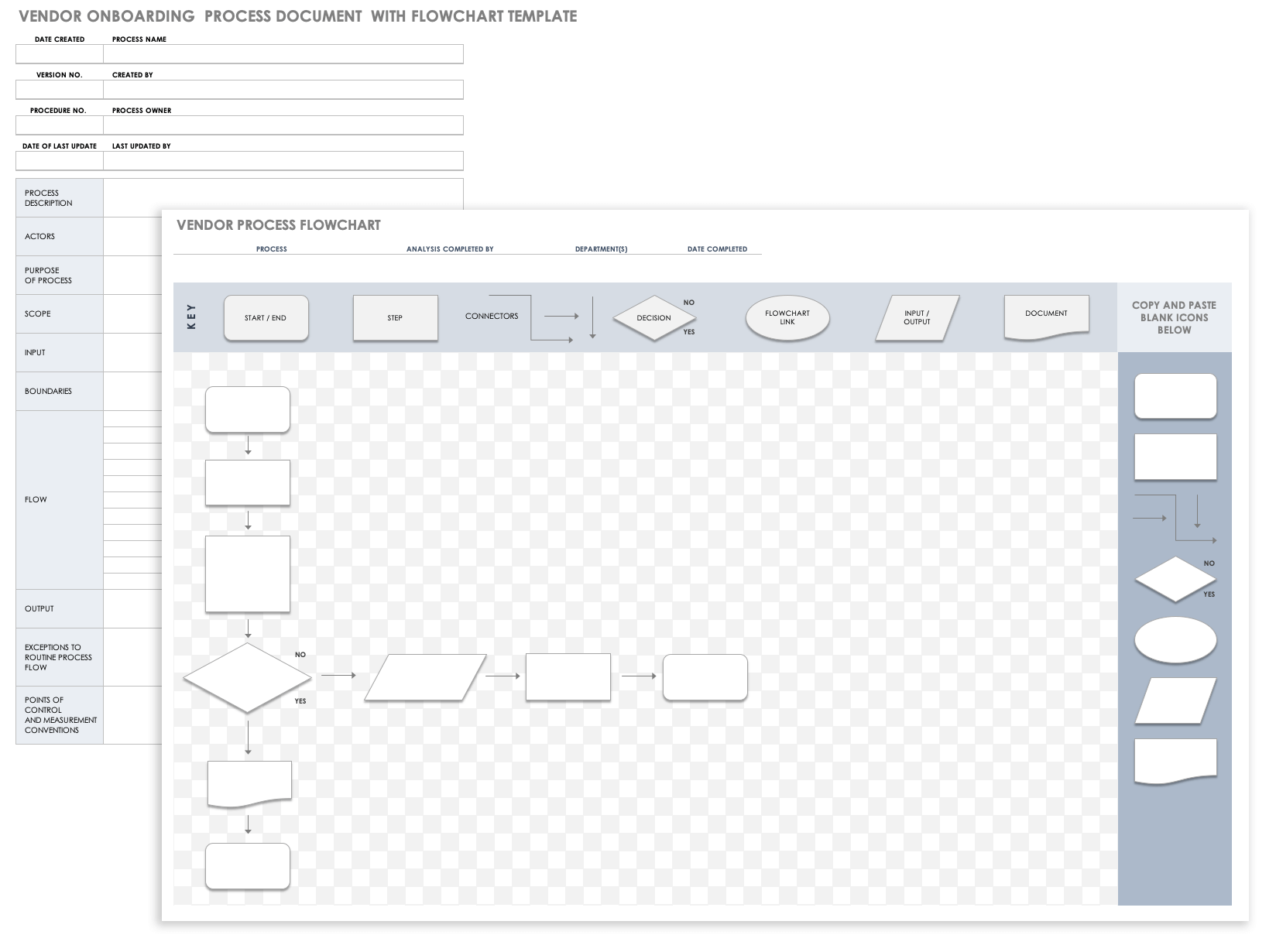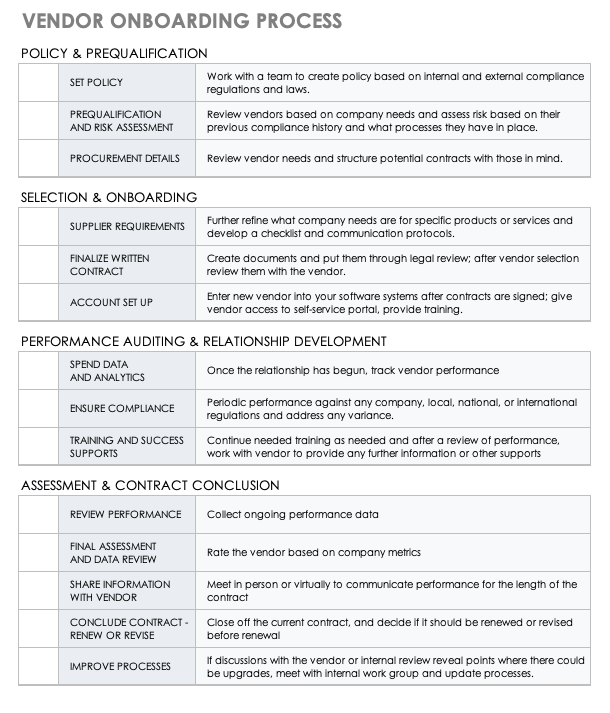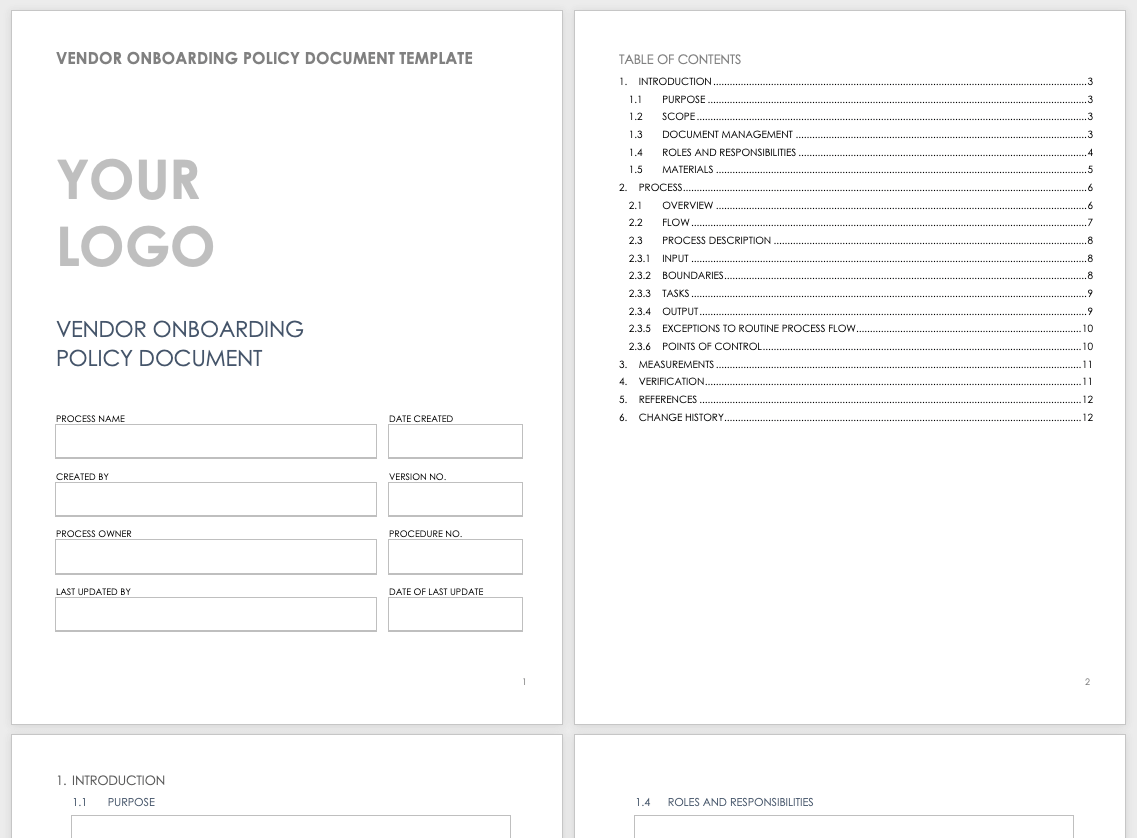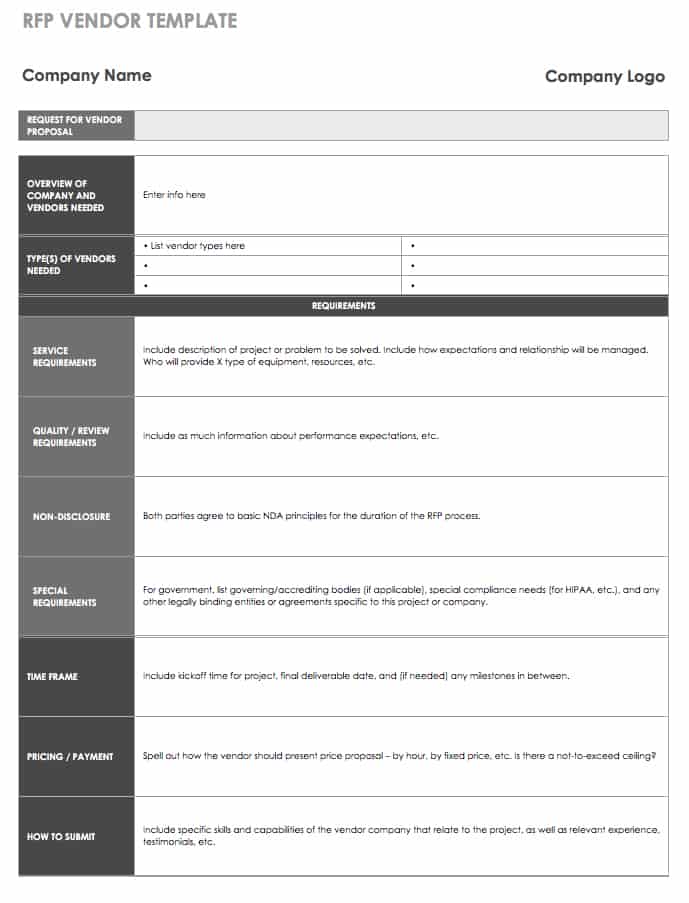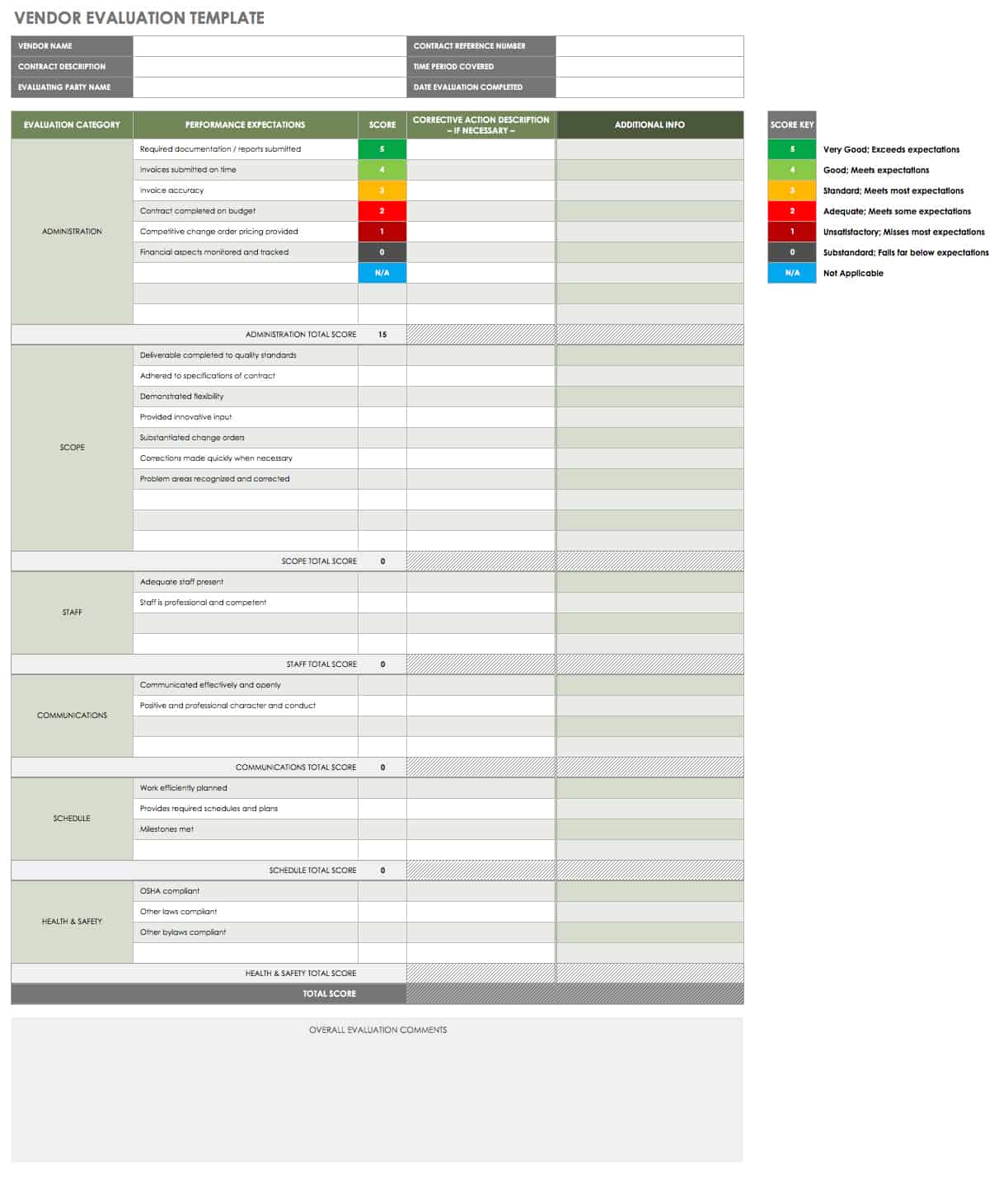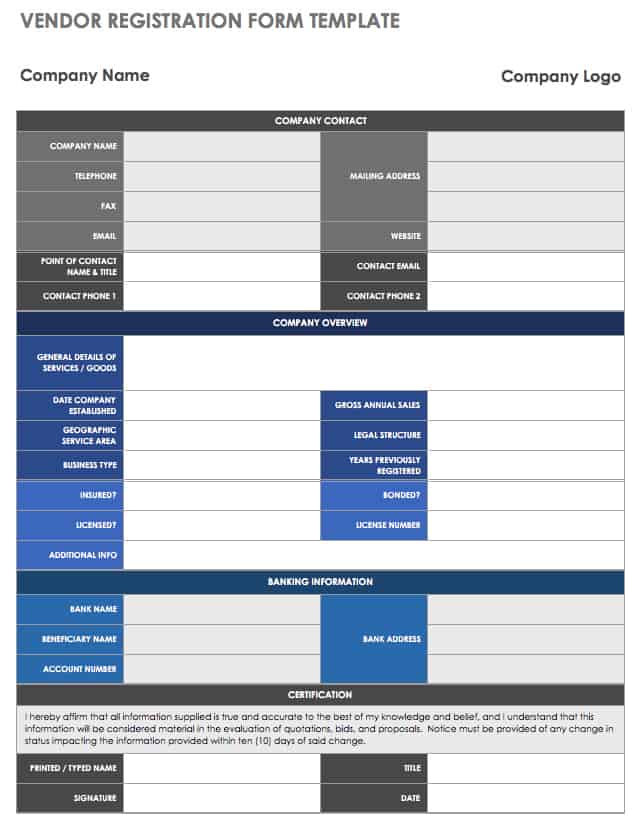What Is Vendor and Supplier Onboarding?
Vendor onboarding — also known as supplier onboarding or supplier relationship management (SRM) — is a systematic process that enables organizations to efficiently collect documentation and data in order to qualify, approve, and contract vendors, purchase goods or services, and make timely payments to new and existing supply partners.
A vendor or supplier is any entity that sells a product or service to your business, either for your own use or as part of an item you resell over the short or long term.
Vendor onboarding bears similarities to employee onboarding, in which new in-house team members receive an understanding of a company’s practices, processes, compliance regulations, and expectations. To learn more, read “Employee Onboarding Processes: Plans, Best Practices, Flowcharts.”
Vendor Onboarding Best Practices
A well-designed vendor onboarding process can help avoid expensive mistakes, including those that may put your organization at legal or compliance risk.
In this article, we’ll refer to people delivering products or services to companies as “vendors” and the onboarding process as “vendor onboarding.” Here’s a best practices checklist to get you started on a plan that is purpose-built for the way your company does business:
| Due Diligence | |
| Know the Rules | List and understand all internal, local, and global legal and compliance issues that apply to your business. |
| Educate Yourself | Read or take a class on the technical challenges of supplier onboarding in your particular business. |
| Prequalify | Reduce risk and fraud at the start with vendor prequalification. Carefully vet candidates based on their track record, willingness, and ability to meet your vendor criteria. |
| Contract Carefully | You may need different contracts for different types of vendors, and you may need to develop additional governance for strategically important suppliers. |
| Secure Information | At all stages, from planning to final payment, take steps to protect your financial resources and business intelligence by using the latest, most reliable security software. |
| Planning | |
| Get Buy-In from Leadership | The institution and support of top management flow through the organization and drive success. |
| Create a Team | Assign a point person and develop an internal staffing plan. |
| Think Strategically | Design from the viewpoint of global consistency and a 360 perspective that aligns with your business and financial goals, so other systems and processes benefit. |
| Attract the Right Vendors | Learn how to attract and identify the right suppliers, and prioritize suppliers by their value to your business. Then, onboard them in that order. |
| Put Your Process in Writing | Gather critical information, create a policy and approval method, and prioritize which processes to implement. |
| Be Organized | Create a thorough and complete vendor and supplier list, including all the contact information and documentation. |
| Track Data and Spend Analytics | Tracking data is invaluable in understanding where you can make improvements. |
| Training and Communication | |
| Implement Internal Training | Ensure that team members thoroughly understand your process and the associated software. |
| Keep Team Members and Vendors in the Know | Set timelines and provide access to relevant, complete, and validated data, so your team can manage and deliver a plan. Share information with your vendors and manage expectations. |
| Train Your Vendors | Train suppliers on your platform and provide them with tips to enable success. |
| Flexibility | |
| Let Continuous Improvement Be Your Guide | Stay flexible and modify processes as you learn what works and what doesn’t. |
Download Vendor Onboarding Best Practice Checklist - WORD
Look into more best practices and expert advice at “Vendor Management 101: The Definitive Guide to Manage Vendor Relationships.”
7 Mistakes to Avoid in Vendor Onboarding
Mistakes in vendor onboarding are typically failures related to accountability, planning, training, compliance, and follow-through. Sticking to the above best practices and avoiding the following common pitfalls create substantial benefits for your company.
Here’s a checklist of seven areas to consider as you design your process:
| Failure to Get Buy-In from Top Management | Success relies on top-down support throughout the organization, from the CEO to warehouse workers. |
|---|---|
| Failure to Assign Responsible Team Members | Accountability on the part of your business is a pillar of success — accountability on the part of your vendor partners will follow. |
| Failure to Plan | A laissez-faire attitude will inevitably lead to performance problems and bumpy relationships. |
| Failure to Train | Training needs to take place internally and externally. |
| Failure to Complete Due Diligence | Failure to vet your potential vendors and lack of attention to compliance issues will make success an uphill battle. |
| Failure to Communicate | Keeping vendors and everyone in your organization in the know is key to continued success. |
| Failure to Build In Flexibility | Continuous improvement requires a willingness to refine based on the data you collect as you progress in your onboarding process. |
Download Vendor Onboarding Failures: Mistakes to Avoid Checklist - Word
Benefits of a Strategic Vendor Onboarding Process
Shifting procurement and vendor relationships from an accounts payable function to a more strategic position in your organization creates benefits including greater competitiveness, improved efficiency, lowered risk, stronger relationships, and a more powerful brand. Read about each of these key benefits in detail below:
- Greater Competitiveness: Many firms in manufacturing and healthcare spend more than 40 percent of every sales dollar on purchased materials and goods. Consequently, vendor management and close attention to buying performance are critical determinants of a firm's competitiveness.
- Improved Efficiency and Profitability: When you streamline current buying processes and make use of data collected about vendor performance, you can avoid income and productivity losses by reducing redundancies, tracking costs, clarifying expectations, and aligning purchasing processes with organizational goals. Streamlining also leads to less waste, higher productivity, reduced startup times, and, consequently, an improved overall ROI.
- Risk Mitigation: When you comply with industrial and government regulations, vet your internal policies, validate your vendors, and educate them regarding your requirements, you avoid problems down the line. You can also mitigate risk by employing strategic tools like the Deloitte Model or the Kraljic Matrix in order to segment suppliers based on the profitability they may bring to a relationship and the threats they may pose. Learn more about risk reduction in this “Definitive Guide to Vendor Risk Management.”
- Stronger Relationships: Vendor onboarding best practices build mutually beneficial partnerships that include training and ongoing communication, review, and approval. These practices prevent relationship breakdowns that may disrupt supply chains.
- Boost Brand: A poorly performing vendor or a difficult relationship can negatively impact your brand and cause reputational damage. Your brand is an extension of you, your products or services, and your character as a company; therefore, it’s malleable and can be formed by others’ perception — or, if approached intentionally, by you. Take charge of vendor performance to enhance your reputation with customers, shareholders, and present and future employees.
Thinking and acting strategically about procurement makes sense for organizations of any size, but it’s essential for organizations that have a large number of vendors and locations. For example, the retailer Walmart has over 100,000 vendors and consumer goods giant Proctor and Gamble has over 75,000. To stay competitive, they have adopted an organization-wide mindset to procurement and onboarding that prevents duplication costs, delivery, and quality failures.
Vendor Relationships That Benefit from Onboarding
All vendor relationships benefit from a formal onboarding process that clarifies requirements, according to Mahmoud J. Alabbasi, General Manager of Hollingsworth Distribution Systems. Alabbasi is an expert in identifying vendors who fit his clients’ criteria and who are willing to follow their processes. “The most critical item for all vendors to look for is an understanding of their customers’ quality metrics and on-time delivery demands. Making sure that you thoroughly understand your customers’ needs and implement those requirements is a key success factor for both parties in the vendor relationship.”
Since vendors work primarily off site (or even offshore), it’s imperative that you use vendor onboarding to bring different types of product and service providers into alignment with your workflow, timeline, payment, compliance, and regulatory needs. Examples of vendors or subcontractors who benefit from onboarding may include the following: vendors who have centralized vendor systems; managers, workers, or third-party field technicians who work for government entities; or private sector companies who work in manufacturing, retail, healthcare, or technology.
You can view onboarding as a strategic component to meet overall company goals and, ultimately, profitability. For insights and action items, read “Transform Your Business with Enterprise Resource Planning.”
Define Your Strategic Vendor Onboarding Process to Improve Workflow
Shifting from traditional, tactical purchasing methods to a strategic engagement with vendors and suppliers saves time and money, and can potentially reduce the number of vendors you work with — a real money saver.
Below is a comparison chart that illustrates the differences between “old school” tactical methods and a strategic perspective:
The best strategy to efficiently control vendors, suppliers, and workflow is to use data to monitor and improve the onboarding process. According to Aberdeen’s 2015 report, The Value of Strategic Supplier Data Management, companies that are leaders in supply chain management are over 30 percent more likely to accelerate supplier onboarding and use that business intelligence to refine processes.
The following model provides a framework for continuous improvement:
One of the outcomes of applying a data-driven, continuous improvement approach to your vendor relationships is that you learn to look at the total value of a partnership (beyond the price), and look at metrics beyond the lowest bid. In the food manufacturing, defense, aerospace, and utility industries — where margins are tight and up to 90 percent of annual revenue is tied to vendor contracts according to McKinsey & Company — controlling vendor performance is vital to company survival. Sophisticated operations in these businesses set metrics and quality level standards to structure vendor monitoring and use those standards to write contracts that clearly define partnership and collaboration across all stakeholders.
To learn more about creating successful business processes, take a look at “Save Time by Taking the Time: Creating Workflows.”
Contracts: The Fundamental Building Block of Strategic Vendor Onboarding and Management
Onboarding vendors properly is where long-term and fruitful business relationships begin, and the foundation of effective onboarding is the contractual agreement, according to Tom Reid, Chief Problem Solver for Certified Contracting Solutions, LLC and author of Sustained Leadership WBS.
“Much of that success rests on the quality of your contract,” Reid says. “A contract is a legal relationship, and, like any relationship, it should be treated with an appropriate level of respect.” Based on his experience, Reid shares his top seven vendor onboarding tips:
| Clarity Counts | As you enter an agreement, be abundantly clear about what the contract requires. When you rely solely on boilerplate, you usually leave out important things and include unnecessary terms. |
| Choose Wisely | To avoid problems, choose your partners wisely. Make appropriate background and past performance checks. Conduct a pre-award survey if appropriate. Look for the character in the people you deal with. |
| Clauses Cost | Keep extraneous words out of the agreement. Make sure that you and your vendor have read and understood the contract and that you both understand and respect the vendor’s roles and responsibilities. |
| Negotiate to Win | Design the negotiation process to build the relationship. Reid prefers to follow the process described in Getting To Yes, by Fisher, Ury, and Patton. The book models win/win negotiations and works toward building the relationship while creating a quality contract arrangement. |
| Host a Post-Award Conference | Each contract with a new vendor should include a post-award conference in which you review and clarify administrative details, such as preferred communication methods, invoicing and payment requirements, and report, inspection, and meeting requirements. If you conduct this process conscientiously, problems are less likely to arise. |
| Know How to End the Relationship | One area where problems arise is defining with certainty when you’ve completed the contract. You should make the contract clear and review it with your vendor. What are the inspection and acceptance criteria? Are they objective? Do the people conducting the inspection know these criteria? Problems often arise when an inspector or manager disregards those questions and the contract in favor of what they would prefer to see. |
Download Expert Vendor Onboarding Contract Tips and Insights - Word
For more information about creating vendor contracts, read the “Vendor and Contract Management Solution Guide.”
How to Automate Vendor Onboarding: Choose the Right Software
There are three overriding considerations for any business looking for vendor onboarding software that centralizes purchasing:
- Easy integration with internal platforms and systems already in use
- A self-service portal for vendors
- Security to guard against cyber attacks and stolen data
Your ability to justify the cost of vendor onboarding software depends on the size of your business and the number of current vendors you work with. If you currently have good relationships with reliable, compliant suppliers, but are planning for future growth, you'll need a system that can scale and handle the more complex needs.
Selecting a cloud-based product allows for two things: flexibility in pricing and the ability for the software to grow along with your business. For example, if you’re a young manufacturing company looking at a way to manage vendor contracts, you may want to have the ability to eventually add features that support stocking, shipping, handling backorders, and being able to use mobile applications to pick, pack, and ship.
The following checklist can help your team discuss and select what’s needed to work with your vendors:
| Approvals | Transparent and streamlined requisition review and approval processes, which result in faster time-to-hire |
| Notifications and Project Management | Deadlines, low supplies, and other time or compliance issues; task assignment, process tracking, and work coordination |
| Payroll Management | Easy and efficient processes to organize vendor contracts, payments, and related expenses |
| Routine Tasks | Category management, centralized and standardized billing rates, invoicing, payment options, and configurable forms and requirements |
| Data Validation and Collection | Visibility into non-sanctioned spending and “scope creep;” electronic signatures |
| Vendor Self-Service | Intuitive portal for vendors to submit electronic forms and documents, information for approvals, and updates |
| Communication | A collaborative digital environment with easy two-way communication via messaging or document sharing between sales, back office, and supply chain teams |
| Search Function | Immediate access to needed data, forms, contracts, invoices, contacts, and other vendor information |
| Platform | |
| Mobile | Ability to use all types of functions on the go in the warehouse, distribution center, transport centers, or anywhere else that facilitates your business |
| Easy Integration | Software that integrates easily with existing systems |
| On-Premises Installation | Control for companies that prefer installed technology |
| Cloud-Based Platform | Easy installation and flexible pricing |
| Workflow and Integration | |
| Workflow Management | Reviews and approvals in alignment with company processes |
| Resource Planning | Software that prevents information silos by integrating and streamlining related functions |
| Compliance and Security | |
| Record Keeping | Critical paper trails and tracking for internal checks and in preparation for audits |
| Due Diligence | Scoping for vendor assessment |
| Security and Risk Mitigation | Centralized solutions with built-in firewalls and other security features to protect company information, trade secrets, and financial resources |
Download Vendor Onboarding Software Features Checklist - Word
Vendor Onboarding Case Studies
“Most parts of the process can be automated using software and online communication,” says Reid. “That doesn’t mean they [parts of the process] should always be automated. Completely removing person-to-person contact doesn’t strengthen the relationship.” Particularly with critical suppliers, make an effort to reach out personally and check in.
Here’s an example of vendor relationships at work in one of the world’s largest companies. In 2017, the Boeing Corporation spent almost $60 billion with nearly 13,000 suppliers worldwide. Increasing price pressure from smaller rivals as well as from Airbus, its chief rival, meant that Boeing had to look at ways of reducing costs to maintain its profit margins.
To improve profitability, Boeing began an initiative called Partnering for Success. Under Dennis Muilenberg, the company has worked with vendors for discounts. In return, Boeing has offered to help vendors control their own costs, as they increase volumes and overall efficiency. For example, GM Nameplate, which provides Boeing planes with approximately 1.6 million placards and signs, agreed to speed up production and supply price discounts in the range of 15 to 20 percent.
Hollingsworth’s Alabassi believes it’s essential to take time at the outset to locate the right vendors. Hollingsworth has developed a thorough proprietary intake form to pinpoint the right vendor for the right relationship. “The Hollingsworth Distribution Systems Supplier Survey helped us reduce the amount of RFQs that Hollingsworth was sending to the wrong suppliers,” Alabassi says. “The survey essentially streamlined our onboarding process by helping us create a place where all questions would filter to the appropriate team.”
Vendor Onboarding Templates to Design Your Custom Process
You can use templates to streamline the creation of documents, like questionnaires, assessments, registration, and contracts, based on your needs. The templates below are completely customizable, so you can include what applies to your company add other items to suit your needs, and design vendor onboarding that will move your business to the next level.
Vendor Onboarding Process Document Template with Flowchart
Use this template to develop a customized onboarding process that aligns with your business goals. This template includes both a simple written document and a flowchart that you can use to visualize the steps.
Download Vendor Onboarding Process Document with Flowchart - Excel
Vendor Onboarding Process Template
This customizable template provides a single form to define and track policy and prequalification, selection and onboarding, performance auditing and relationship development, and assessment and contract conclusion steps in your onboarding process.
Download Vendor Onboarding Process Template
Vendor Onboarding Policy Template
Having clearly defined policies and expectations improves internal efficiency and relationships with your vendors. Use this easy-to-modify template as the basis for a shareable document that states your company’s requirements and strategic goals.
Download Vendor Onboarding Policy Template
Request for Proposal (RFP) Vendor Template
This request for proposal form (RFP) template specifies project or proposal requirements for existing or new vendors, and helps foster a positive relationship with potential partners.
Download RFP Vendor Template
Excel | Word | PDF | Smartsheet
Vendor Evaluation Template
Vendor Registration Form Template
Use this registration form template for new vendor applications or internal documentation. Edit the template to include details relevant to your company.
Download Vendor Registration Form
Vendor Risk Assessment Template
Identify specific vendor relationship risks using this template. Once risks are clarified, you can move forward on a decision to cancel, monitor, or work with new or existing vendors based on facts.
Vendor Assessment and Scorecard Template
Use this template to gather data into a spreadsheet, apply a vendor scoring system, and then select a single supplier or compare multiple current or future suppliers.
Vendor Contract Template
Use this PDF template to outline terms and conditions and provide a clear source of documentation for all parties in the transaction. This template contains common vendor contract elements including work scope, timeline, payment terms, and more.
Smartsheet Vendor Onboarding for Stronger Relationships and Improved Profitability
Empower your people to go above and beyond with a flexible platform designed to match the needs of your team — and adapt as those needs change.
The Smartsheet platform makes it easy to plan, capture, manage, and report on work from anywhere, helping your team be more effective and get more done. Report on key metrics and get real-time visibility into work as it happens with roll-up reports, dashboards, and automated workflows built to keep your team connected and informed.
When teams have clarity into the work getting done, there’s no telling how much more they can accomplish in the same amount of time. Try Smartsheet for free, today.


